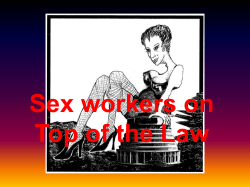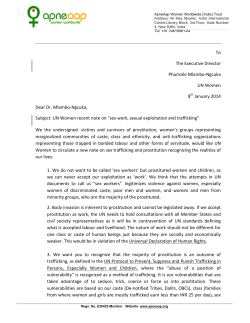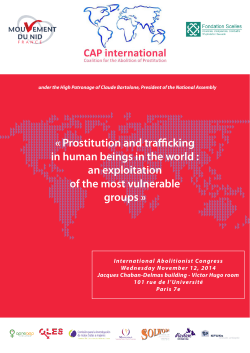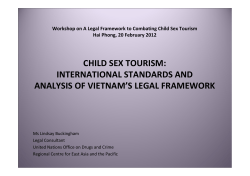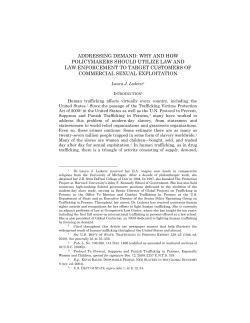
Two Articles on Prostitution
Developing Feminist Politics on Prostitution 1 © 2015 Kvinnefronten / The Women’s Front of Norway Publisher: Kvinnefronten / The Women’s Front of Norway Kirkegt. 5, N - 0153 Oslo, Norway E-mail: post@kvinnefronten.no Tel: + 47 957 98 114 www.kvinnefronten.no Editor: Agnete Strøm, international co-ordinator Mail to: agnetest@online.no Layout & cover: Natasha Alijeva www.divinemadness.no CONTENTS Two Articles on Prostitution Developing Feminist Politics on Prostitution Agnete Strøm The Presence of Pain in the Debate on Prostitution Cecilie Høigård 01 06 07 16 Developing Feminist Politics on Prostitution Paper given at the panel: The Human Rights Abuse Inherent to the Sex-Trade NGO CSW59 FORUM, New York, 14th March 2015 Our fight to abolish prostitution started in 1870 in England, and from there it spread out to encompass the whole world. Josephine Butler started this political campaign she is our feminist foremother. Kathleen Barry writes about Josephine Butler in her book Female Sexual Slavery in the chapter Josephine Butler: The First Wave of Protest. I will quote some here. During the first French revolution 1789-1799 venereal diseases became a major problem in the armies; it was so widespread that it often undermined military effectiveness. This situation motivated a renewed interest in regulating prostitution. The chief concern was to 01 Developing Feminist Politics on Prostitution find a way to prevent disease without inhibiting soldiers’ access to prostituted women. The practice of regulation of brothels quickly spread from the military to the general public. By the middle of 19th century this system evolved into regulation of prostitution through brothels. First in France and Germany and then across Europe, prostituted women were forced into the brothels as the only place they could legitimately work. In 1864 in England a Contagious Diseases Acts were passed. To Josephine Butler, the Contagious Diseases Acts formalized and legalized the sexual enslavement of women. The Acts were designed to protect the health of military men by subjecting any woman the special Morals Police identified as a prostitute to a “surgical examination”. “Surgical examination” involved the use of crude instruments by often-cruel doctors for vaginal examinations. If the woman refused she would get 6 months prison and hard labour. Josephine Butler responded with a war against the tyranny. She started a campaign for destruction of the sexist double standard of morality, and demanded personal liberty for all women. What distinguished Josephine Butler from many of her contemporaries was that in her recognition of sexual slavery she attacked those who profited from the practice slaveholders, procurers and the State. The women who were organizing against the CD Acts had to fight the social attitude and belief within themselves that men were their intellectual and moral superiors. For this reason and because she believed that the injustices of the CD Acts would always be felt Developing Feminist Politics on Prostitution 02 more keenly by women, Josephine Butler insisted on separate Ladies Associations throughout her political career. By 1886, when the CD Acts were finally were repealed, the conditions of prostitution had worsened. International traffic in women was at a peak and the definition of prostitution had changed and solidified. What was the effect of the CD Acts? CD Acts transformed the casual prostitution of working-class women into a specially identified exploitable class. Thus the prostituted women were isolated from general lower-class life and separated from their neighbourhoods into distinct red-light districts and brothels, made identification of the prostituted women more specific and in effect “industrialized” and therefore their ability to leave prostitution much more difficult. In the early days of the Acts, in the 1870-ties, most prostituted women were young an single; by the late nineteenth century the rigidity of this social role resulted in women’s remaining in prostitution longer. Their social mobility had been effectively curtailed. The impact of the CD Acts created among women a distinct out-group and, in which women were socially if not physically trapped. This social and geographical isolation facilitated the criminal organization of prostitution complete with pimps, procurers, and organized brothels. Josephine Butler took up the issues of prostitution as female sexual slavery and trafficking and called for a fundamental value change. Her work was far in advance of social consciousness of her day, but left us with a false distinction between free and forced prostitution. 03 Developing Feminist Politics on Prostitution It took us a century after Josephine Butler’s campaigns to change the shift of blame for prostitution to the customers who buy women to use/abuse them for sex. We now understand that without a market demand from men, the buyers of prostitution, there would be no prostitution. She and the next generation of feminists argued that paternalism has separated the issue of moral exploitation from the political position of women vis-à-vis men. They lobbied the issues politically in The League of Nations and later in the United Nations with success. In 1949 United Nation agreed on the Convention for the suppression of Traffic in Persons and the Exploitation of the Prostitution of Others which states that prostitution and the accompanying evil of traffic in persons for the purpose of prostitution are incompatible with the dignity and worth of the human person and endanger the welfare of the individual, the family, and the community. An important advance against the prostitution of women, this law left the customer, the buyer of women, untouched. In 1979 UN agreed on the Convention on the Elimination of all Forms of Discrimination Against Women, CEDAW, which obligates State Parties to take all appropriate measures, including legislation, to suppress all forms of traffic in women and exploitation of traffic in women. In 2000 UN agreed on the Palermo-protocol, which called for legislative or other measures…..to discourage the demand that fosters all forms of exploitation of persons, especially women and children, that leads to trafficking. Developing Feminist Politics on Prostitution 04 Here we are approaching the important and crucial role of the buyer of women who creates the demand for prostituted women, but only in connection with trafficking. The legacy handed down from Josephine Butler via Kathleen Barry to us is the legacy that we have to pass on. But what is our actual situation now? We have the UN charter, the 1949 convention, the CEDAW convention and the Palermo protocol. With the Nordic Model recognize prostitution as violence against women whether or not women are trafficked we have got legislation that criminalize the buyers/the johns. This legalization is now being implemented in several countries since Sweden, Norway, Iceland and Northern Ireland. And we have got organisation SPACE International, which, as Josephine Butler did, responds with a war against the tyranny, a campaign for destruction of the sexist double standard of morality, and a demand for personal liberty for all women. These tools will serve us well. Different UN-offices experience at the moment an inroad of paternalistic male self-interest that already has put a distinct pro-prostitution mark on their policies, UN Women and UNAIDS are two good examples. UN Women’s Note on sex work, sexual exploitation and trafficking from 2013 is still valid: …We cannot consider sex work the same way we consider trafficking or sexual exploitation, which are human rights abuses and crimes, and …. supports the regulation of sex work in order to protect sex workers from abuse and violence… 05 Developing Feminist Politics on Prostitution UNAIDS’ report HIV/AIDS 2012 recommends: Repeal laws that prohibit consenting adults to buy or sell sex, as well as laws that otherwise prohibit commercial sex, such as laws against “immoral” earnings, “living off the earnings” of prostitution and brothel-keeping. UN-offices try to break down and eliminate our abolitionist and feminist cause. We will not let it happen, so let us discuss, what can be done. Agnete Strøm Developing Feminist Politics on Prostitution 06 The Presence of Pain in the Debate on Prostitution The editorial in the periodical Materialisten 2014 1-2 In the seventies and eighties, I was a member of a working group on prostitution. The group consisted mainly of Swedish and Norwegian researchers and social workers, including among others Hanna Olsson, Sven-Axel Månsson and Stig Larsson from Sweden as central researchers. Many of us spent several years doing fieldwork in areas with a large amount of prostitution, respectively in Stockholm, Malmö, Gothenburg and Oslo, and as a result we developed close relationships with the participants in the sex trade. We heard stories about their past abuse, extreme poverty, violence and institutionalization. We were well prepared for those stories, due to our experiences with earlier field studies on outcasts and marginalized people. The stories of the content of prostitution, put in concrete terms, were more unexpected 07 The Presence of Pain in the Debate on Prostitution and shaking. The women gave us specific details of the prostitution trade, and how it affected them. They told us how it was to use their bodies and vaginas as rental apartments for unknown men to invade. This made it necessary for them to try to separate their bodies from their souls: ‹‹Me and my body are two separate parts. It is not me, my feelings or my soul he fucks. I am not for sale.» The women’s strategies to maintain this separation were numerous and ingenious. To be agents in their own lives they showed great ingenuity and vigor within the little space of maneuver they had in the sex trade. In time it became more and more difficult for them to adhere to the separation between their bodies and souls, the necessary part to distance themselves from the merchandise of their bodies. After the customer was done, it became increasingly difficult to bring back the self again. Eventually the women started to feel worthless, dirty and disgusting. These stories were very similar to accounts we have heard from victims of other sexual violence, such as incest, rape and domestic violence. The empirical data shown in the extensive Scandinavian prostitution research was supported by the international literature on the subject. Regardless of how the women felt was the best way to approach prostitution, for example legalization, decriminalization or criminalization, the books and reports based on long and close contact with prostituted women showed the same patterns of division, pain and scars in their souls. When the women could talk freely to people they knew well and whom they had gained confidence in, the most horrific contents of the sex trade would be revealed in most of their stories. In our research group we disagreed about a lot of things, but we shared the same feelings of despair for the women’s pain and for the many whorecustomers lack of knowledge regarding the consequences The Presence of Pain in the Debate on Prostitution 08 of their actions. In the end of the seventies, the idea of one-sided criminalization of the whorecustomer struck me at that time like lightning. The idea increased my heart rate immediately, and gave me a sense of something falling into place. I felt for a moment some ingenious for once. I had never come across that angle in the extensive literature that I had read on the subject of prostitution. But as recent history has shown, there was of course no reason to feel hubristic about it. Individuals do not create social changes. At best, one can only hope during a life in research once or twice to plant a seed or put an idea into social movements that has the necessary force required to push through social changes. It is the women’s rights movement in Sweden and Norway who have fought for what has later been called the Nordic model; the one-sided criminalization of the whorecustomer. There were also women activists who eagerly seized the idea first. In the Scandinavian working group on prostitution there was huge opposition to the proposal for a long time. (After some years the opponents in the working group changed their point of view; something that requires a certain intellectual courage once one has become nationally known for supporting the opposite side in the matter). In this issue of the periodical Materialisten Korsvik shows how the fight against prostitution - the Abolitionists movement - has been part of the women’s liberation movement’s struggle in both the 1880s and 1980s. Prostitution has been seen as a condensed and extreme expression of the oppression of women. The criminalization of the customers has had greater effects in some areas than even the optimists amongst the advocates of the law were hoping for. The controversial law and the debate that followed, served as a large-scale educational campaign. In Sweden, the attitudes towards the law changed rapidly in a positive direction, and the proportion of Swedish men buying women’s bodies 09 The Presence of Pain in the Debate on Prostitution has decreased. Norwegian experie nces are still missing a thorough evaluation, but the majority of the population is now supporting the law. The current public debate can hardly be recounted in this short editorial, but an important new characteristic of some arguments should be described. Some of the defenders of prostitution are consciously using specific rhetorical configurations when debating, rhetoric you would associate with feminism and left-wingers, but at the same time the content also appeals to the right-wingers. This strategy is well known in other political debates in Sweden and Norway, where rightwing political parties have stolen parts of the left’s rhetoric. In particular, there is the use of three key concepts that are central to the legalization supporters both nationally and internationally. These are the concepts of The Victims, The Trade Unions, and The Sex Worker (see also Ekman, K. Being and being bought, Leopard 2010). The experiences and analysis of the women’s liberation movement in the 1970´s made a profound impact on women’s rights to be victims. Incest, rape and abuse of women, were interpreted as violations made by individual men and simultaneously as manifestations of the social power men have over women. Nobody wanted in the name of feminism to claim that these interpretations should somehow pity the women. Finally, responsibility and shame was placed where it belonged. In the prostitution debate, however, the concept of victims was twisted to ascribe characteristics of individual women in prostitution, saying that to call them victims of the customers was to pity them. This is a clever abuse on the ambiguous use of the concept of victim in everyday speech. Kjersti Ericsson has described very well how men and women act out of different positions in the societal power relations between The Presence of Pain in the Debate on Prostitution 10 the sexes, and also how the concept of being a victim is not about being passive or active, weak or strong. Women are not a passive, weak group, says Ericsson. On the contrary, women often display a frenetic activity and an almost inhuman strength to withstand the burdens the male society places on them (Ericsson, K. Nordic Journal of Criminal Science 1993). The women’s survival strategies against the sex trade and its contents are just examples of such activity and strength (Høigård, C. Nordic Journal of Women’s Studies 1993). The interpretation and critique of the concept of victimization, however, gave a certain resonance in both a small part of the left side, and even more so among the right-wingers. The left side enjoyed the image of proud women who made their own choices and shaped their own lives, it was seen as something subversive against the prevailing repressive sexual norms. The right-wing has traditionally fought against measures to secure gender equality such as implementing quota systems for women, because such measures allegedly do take pity on women. Also, the idea that every individual is solely responsible of making their own happiness in the free market is very strong among the rightwingers. Both winners and losers should blame themselves. By removing the term victim, the abuse and the abuser are removed as well, and by attacking the concept of victimization, one creates a distance from the reality and pain inside prostitution. The concept of trade unions for sex workers is the second key concept. The first and most known “trade union” was Coyote (Call Off Your Old Tired Ethics). It was founded as early as 1973, and financed by Playboy and other porn magazines. Among the leaders were well known pimps who wanted to extend the market of prostitution. Coyote made «whore balls» under the slogan “Everyone needs a whore now 11 The Presence of Pain in the Debate on Prostitution and then”, and auctions were held where a prostituted woman would be given to the highest bidder. It was also Coyote who introduced slogans like: «Hookers of the World Unite, Organizing the Oldest Profession.» Only a small proportion of the members of Coyote had experiences from prostitution, and even fewer were involved in prostitution. Coyote did however manage to implement some changes that women in prostitution would benefit from, for example to abolish the quarantine regulations for women who waited to test for gonorrhea. But their aim was to mainstream the argument that prostitution has to be recognized as a common profession for women. With Coyote, once feminist arguments started to be used as a defense for prostitution. Several organizations with similar ideologies have later been founded. The Swedish cultural journalist and author Kajsa Ekman, was curious about what was hiding behind the concept of sex workers´ trade unions. She traveled around Europe for about two years, and interviewed the leaders of these organizations (ibid.). She found that the members were a mix of pimps, lobbyists for the sex industry and that very few of the members were actually prostituted women. The trade union’s demands mentioned to Ekman were salary, unemployment funds, working conditions and pensions. But these requirements had no substance in reality, as nobody was working with these matters. The Dutch De Rode Draad a well-known Dutch “trade union” for sex workers, gave Ekman this answer as an example of their trade union struggles: «The trade union has prevented the concept of closing hours in Red Light Districts introduced by the municipal attorneys.» You would think that a trade union would choose to fight for the employees need for shorter working days, rather than a larger share of profits gained from the merchandise of human bodies. Longer opening hours are certainly an advantage for brothel owners and the owners of the windows where prostituted Dutch The Presence of Pain in the Debate on Prostitution 12 women are exhibited. Ver, the Dutch brothel owners’ association, also has a link to De Rode Draad on their website. Despite the low number of members and total absence of trade union struggles, De Rode Draad is leading their own mythical life in anthologies on prostitution, on the Internet and especially in the sex industry. Ekman sums up that she was not able to find a single organization that deserved the name of trade union; an organization that is operated and funded by members who make trade union claims to a counterparty. The concept of trade unions appeals to left-wingers and feminists. Trade unions create a picture of a collective struggle for common interests. Ironically, this concept also appeals to parts of the right side when it comes to the context of prostitution. Only then are they supporting trade unions, a social movement they otherwise detest and fear. No need to worry! These trade unions are not engaged in union struggles. If they did, one could ask: Who would be their counterpart? Customers? Brothel owners? Users of the concept of trade union do not see any conflict of interest between these actors and the women in the sex trade. The real enemy, the power of man’s oppression on women, is replaced with an enemy image of a bigoted women’s movement. It is claimed that the problem with prostitution is not prostitution itself, with its contents of physical and psychological violence and oppression of women, but the stigmatization the prostituted women meet from uptight women. What these unions are primarily engaged in is distribution of propaganda to legalize prostitution. Only when prostitution is legalized and the stigma is removed, the real union work can begin. At the same time these organizations are established in countries where it is neither forbidden to sell or buy sex, and where at the moment there are no legal obstacles to organize and engage in trade union struggles. If the purpose is to legitimize prostitution as normal work, however, and to add 13 The Presence of Pain in the Debate on Prostitution a distance to what prostitution contains and the pain it causes for the women involved, one can simply create an organization and name it a trade union (ibid., p 75). The concept of trade unions is related to the third key concept: The sex worker. This concept can also receive some ideological recognition on both the left and the right side. The struggle for workers rights is a huge matter for the left side. The notion of the free market where people can trade their goods and services without any restrictions, and where the market’s oppression of poor people’s needs is an just and natural consequence, are neoliberalism and right-wing notions. As a continuation of the arguments against the current law that criminalizes the purchase of sex, we find the little noticed consequence that a larger market for prostitution with then a larger demand would be better than the current market. The greater the market for prostitution, the more customers will be generated. The more customers, the shorter the women have to wait for their turn. The more customers, the easier it becomes to screen out the violent ones. The more normalized prostitution becomes, the easier and less shameful men´s exploitation of women´s bodies becomes. The concept of the sex worker is definitely not intended to abolish prostitution neither in its scope or in its content, but to transform the image of prostituted women to free, independent commodity owners of their own bodies, and to transform the customers into purchasers of common services just as haircuts and car washes. In this picture the documentation of the extreme mortality worldwide (murder, suicide, drug use and alcoholism) among prostituted women have no space. To consider the sale of a woman’s body as normal work, the body must be separated from the self; it is not the free active self that is sold to satisfy multitude of unknown men’s sexual needs, it is just sexual services, like other sold services. The concept of the sex The Presence of Pain in the Debate on Prostitution 14 worker who sells sexual services creates an illusion of the body and soul seamlessly joining together again once the transaction is over. The image of a sex worker is yet another way to create a distance between prostitution and the suffering that goes into it. The prostituted women’s attempts to divide the body and self is a survival mechanism used in an activity she experiences as immensely degrading. Among advocates for legalization, the same underlying schism is used in the concept of the sex worker as a laundering of the business. It is not difficult to understand and respect that some women in prostitution need to present their situation in this manner. Ericsson calls it “to choose the inevitable.” Choosing the inevitable is a way to preserve the pride and sense of being a subject with her own agency, and not an object for other people needs. This is a common strategy among many, many women, but the oppression will never be made visible or challenged by this strategy (ibid.) The objectification of women in prostitution is far stronger than of other women, and their life situations are characterized by very little opportunities for other life strategies. It is almostpeculiar that so few women in prostitution choose this strategy; this also tells how women experience prostitution. For a sociologist of law or criminologist, it is neither difficult to understand nor to respect that people have different views regarding the criminalization of customers. Legislation made out with the best of intentions, have often proved to be full of loopholes, traps and dangers. This applies also when it comes to assistance and support projects. Legislation in support of oppressed groups requires continuous pressure from activists and grassroots movements to be enforced. We see this in Sweden and Norway where the enforcement of the sexbuying 15 The Presence of Pain in the Debate on Prostitution law varies a lot. The grassroots movement must again take action, the fight against women’s oppression is similar to housework, with its constant recurring labour and the performing of repetitive tasks. Under the prevailing power and social conditions this is how it works, and believing there is a simple one-factor solution to fight prostitution and women’s oppression, is in my point of view just as naive as to be disappointed that a single law does not remove prostitution and female oppression. Even so, it is still a lot better with laws that put down some boundaries against abuse, than a society where abuse is legal. I admit that it is more difficult to understand and to respect the part of the opponents to the law, who choose to veil the overwhelming documentation of pain in prostitution, and would want us to look the other way. These opponents develop a specific rhetoric that creates comfortable and protective gray areas for the customers and creates the greatest possible distance to the contents and suffering in prostitution. This makes it very difficult to establish even the most precarious common ground to continue a meaningful dialogue. Cecilie Høigård Translated by Daisy Elizabeth Sjursø The Presence of Pain in the Debate on Prostitution 16
© Copyright 2025
